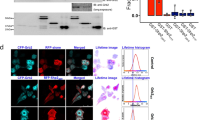Abstract
SHPS-1 is an ∼120 kDa glycosylated receptor like protein that contains three immunoglobulin-like domains in its extracellular region as well as four potential tyrosine phosphorylation and SRC homology 2 (SH2) domain binding sites in its cytoplasmic region. Lysophosphatidic acid (LPA) stimulated the rapid tyrosine phosphorylation of SHPS-1 and its subsequent association with SHP-2, a protein tyrosine phosphatase containing SH2 domains in Rat-1 fibroblasts. LAP-induced tyrosine phosphorylation of SHPS-1 was inhibited by Clostridium botulinum C3 exoenzyme (which inactivates RHO) but not by pertussis toxin. The protein kinase C activator phorbol ester, 12-O-tetradecanoylphorbol 13-acetate (TPA) also stimulated tyrosine phosphorylation of SHPS-1; however, down-regulation of protein kinase C by prolonged exposure of cells to TPA did not affect LAP-induced tyrosine phosphorylation of SHPS-1. LPA-induced tyrosine phosphorylation of SHPS-1 was markedly reduced in either focal adhesion kinase (FAK)-deficient mouse cells or CHO cells overexpressing the tyrosine kinase CSK. Overexpression of a catalytically inactivate SHP-2 markedly inhibited MAP kinase activation in response to low concentrations of LPA in CHO cells, whereas overexpression of a wild-type SHPS-1 did enhance this effect of LPA. Furthermore, MAP kinase activation in response to a low concentration of LPA was inhibited by botulinum C3 exoenzyme. These results indicate that LPA-induced tyrosine phosphorylation of SHPS-1 and its association with SHP-2 may be mediated by a RHO-dependent pathway that includes FAK and a SRC family kinase. Thus, in addition to its role in receptor tyrosine kinase-mediated MAP kinase activation, the formation of a complex between SHPS-1 and SHP-2 may, in part, play an important role in the activation of MAP kinase in response to low concentrations of LPA.
This is a preview of subscription content, access via your institution
Access options
Subscribe to this journal
Receive 50 print issues and online access
$259.00 per year
only $5.18 per issue
Buy this article
- Purchase on Springer Link
- Instant access to full article PDF
Prices may be subject to local taxes which are calculated during checkout
Similar content being viewed by others
Author information
Authors and Affiliations
Rights and permissions
About this article
Cite this article
Takeda, H., Matozaki, T., Fujioka, Y. et al. Lysophosphatidic acid-induced association of SHP-2 with SHPS-1: roles of RHO, FAK, and a SRC family kinase. Oncogene 16, 3019–3027 (1998). https://doi.org/10.1038/sj.onc.1201839
Received:
Revised:
Accepted:
Published:
Issue Date:
DOI: https://doi.org/10.1038/sj.onc.1201839
Keywords
This article is cited by
-
The role of Src homology 2 containing protein tyrosine phosphatase 2 in vascular smooth muscle cell migration and proliferation
Acta Pharmacologica Sinica (2010)
-
Activation of RhoA and FAK induces ERK-mediated osteopontin expression in mechanical force-subjected periodontal ligament fibroblasts
Molecular and Cellular Biochemistry (2010)
-
The possible role of signal regulatory protein α1 in hepatocellular carcinoma
The Chinese-German Journal of Clinical Oncology (2003)
-
A role for SHPS-1/SIRPα1 in IL-1β- and TNFα-dependent signaling
Oncogene (2002)
-
Roles for the protein tyrosine phosphatase SHP-2 in cytoskeletal organization, cell adhesion and cell migration revealed by overexpression of a dominant negative mutant
Oncogene (2000)



